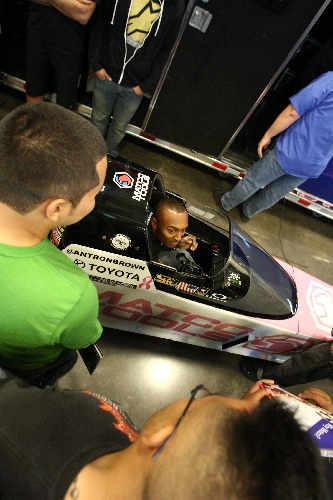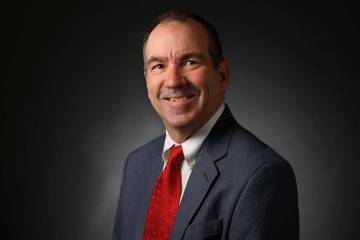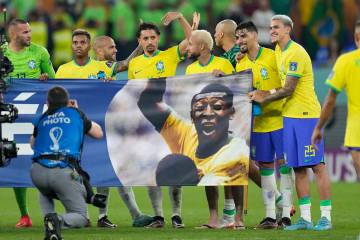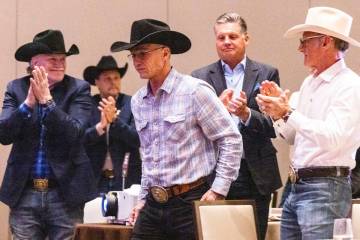For drag racer Brown, progress has no color
It was a little past 10 a.m. Wednesday, and Antron Brown - 5 feet 9 inches, 145 pounds, 0 to 60 in .48 seconds - was speaking to a captive audience of about 60 students in the auto shop at the way, way back of the College of Southern Nevada's Cheyenne campus.
He was wearing a black pullover with "Matco Tools," his sponsor, stamped in blue letters on front; black trousers; black shoes; and he didn't appear to be wearing socks - or maybe just the kind that come only as high as one's ankles, because those are more aerodynamic.
When I walked in, he was telling these students that his Top Fuel dragster, which sat motionless and, thankfully, quietly behind him - it was much too early in the morning for the high-pitched whine of 800 ponies in the engine compartment - was "the fastest-accelerating vehicle on the planet."
And you could tell from the raised eyebrows and the looks on the faces that these students were impressed.
The faces were young and not so young, white and black and brown, and some were female faces, and one of the faces had a long, scraggly ZZ Top beard hanging from it.
In other words, the faces of the automotive and diesel technologies students looked a lot like the faces under the helmets of the NHRA drivers - except for the one with the ZZ Top beard (unless John Force hasn't shaved since Reading). And those faces look a lot like the collective face of America.
And so whereas it's a pretty big deal to Brown that he is on the verge of winning his first Top Fuel dragster championship, he doesn't talk so much about becoming the first African-American to capture a major American auto racing season title, unless you bring it up.
He doesn't look at it that way, in black and white or shades of brown; or that in his last race, he lost in the finals to Khalid alBalooshi, who is from Dubai in the United Arab Emirates and drives for a sheik, and a most excellent one at that: His Excellency Sheik Khalid bin Hamad Al-Thani, prince of Qatar, whose father has 22 sons - at last check - by various wives.
You see, it's all one big melting pot in the NHRA. Has been ever since Shirley Muldowney won the Top Fuel title in 1977, to be followed by other women who were excellent drivers, and African-Americans such as Brown, and various Pedregons, and now, even an alBalooshi who drives for an excellent sheik.
"Doing what I am doing now is one of those American dreams where you can say it turned into a reality," said the 36-year-old Brown, who was a speedster on two legs before becoming one on four wheels (in college, he clocked 4.27 in the 40-yard dash); whose fifth season as a Top Fuel driver has produced six event titles and a commanding lead in points with two races to go.
If he has a good weekend at the Big O Tires NHRA Nationals at Las Vegas Motor Speedway beginning Friday - and Spencer Massey, his Don Schumacher Racing teammate and closest pursuer, has a tough one - Brown could clinch the title even before leaving town.
Forget what Brown can do for you. That's what Brown can do for himself.
"It's so surreal, a kid from Chesterfield, N.J., who grew up watching this sport and now doing what I'm doing now, which is the ultimate dream," said Brown, who began racing professionally on a motorcycle owned by former NFL star Troy Vincent. "But I can tell you one thing: It didn't happen overnight."
But it didn't not happen because of his ethnicity, or because of his modest upbringing in a sport that costs money, lots of money, at least if one wants to compete at the highest levels. At the lower levels, though, you can turn a '72 Chevy Vega into a race car and drag race for trophies on the weekend, which is what Brown's father and grandfather and uncle did even before Antron was born.
"They had a fastback Vega and put a 350 small-block engine combination in it, and they were running like 9.80s back in '74," Brown said, which sounded impressive to a reporter whose first car was a '73 Vega once timed with a calendar.
Brown pulled out his iPhone. He finger-swiped to a picture of that Vega with the 350 under the hood, and the burnt orange paint job, and the decal on the rear deck that said "GET DOWN," harkening to the days of bell-bottoms and "Tubular Bells," of Bachman Turner Overdrive and the Hues Corporation, of long lines at the gas pumps and drag racing on fire roads at the edge of town.
"I give drag racing a lot of credit," Brown said. "Drag racing is the roots of American racing.
"At the tracks I grew up at - Englishtown and Atco and Maple Grove in Pennsylvania - if you went there, it was like street night. You had blacks, you had Hispanics, you had white people - it didn't make a difference. You had everybody. And nobody cared what color you were, or nothing like that, because everybody was out there having a good time just racing each other."
And so on Labor Day weekend, when Brown was matched against fellow African-American driver J.R. Todd in the quarterfinals at the 58th annual U.S. Nationals in Indianapolis - the NHRA Super Bowl - some people said it was progress.
But to most people - and especially to Antron Brown and J.R. Todd - it was just two guys trying to get to the other end of the track first.
Sometimes, progress is best measured when it goes unnoticed.
Las Vegas Review-Journal sports columnist Ron Kantowski can be reached at rkantowski@reviewjournal.com or 702-383-0352. Follow him on Twitter: @ronkantowski.








